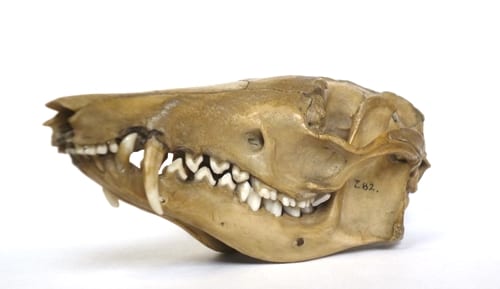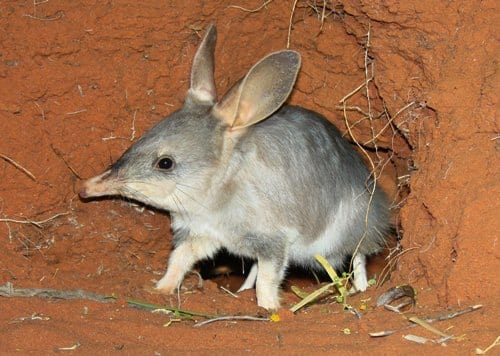Specimen of the Week 306: The Bilby Skull
By Jack Ashby, on 1 September 2017
Australia is widely considered to be the extinction capital of the world. In the 230 years since European invasion, 29 of its 315 native land mammals have been driven to extinction, and by far the majority of those that do currently survive have suffered significant (and in many cases almost total) declines – they are now only found in a fraction of their former habitats.
This is all very depressing, but as I write this I am undertaking fieldwork in a remote area of central South Australia, volunteering for an organisation who are trying to make things better. This week’s Specimen of the Week is one of the species they protect.
**The Greater Bilby**
Dynamic diggers
Bilbies are extraordinary (and extraordinary-looking) marsupials that do a lot of digging. They dig burrows to shelter, which can reach 3m long and are often spiral-shaped. They also dig to find food – roots, tubers, arthropods and small vertebrates, which they can locate by sound and smell up to a metre through soil. They are famous for their long pointy noses and long ears, which presumably helps with their hunting, but those ears are also adaptations for shedding heat, as they live in some very hot parts of Australia. Their scientific name Macrotis lagotis mentions their ears twice: it means “big ear hare ear”.
Cats and Catastrophe
Greater bilbies are the only surviving member of their family (the Thylacomyidae, which translates as “pouched mice”, though at 1-2.5kg in weight, they are much bigger than mice), and they are closely related to the bandicoot family. Until the 1960s, there was a second member of the family – the lesser bilby, but it is one of the many victims of the feral cats and red foxes which were catastrophically introduced to Australia by European settlers. Predation by these efficient hunters is the chief reason behind the country’s horrific extinction record, and the continued decline of its wildlife today. Incidentally the name “bilby” comes from the Indigenous Gamilaraay language, which is itself extinct.
A species in decline
Somehow greater bilbies have not yet been eaten into oblivion by invasive cats and foxes, but they are in serious trouble. Before Europeans arrived their range extended over 70% of Australia (which is a very big place), but they have since been reduced to about a fifth of their former distribution, and numbers are declining.
Rescue mission
Finding ways to reduce the impact of cats and foxes on bilbies and many other native Australian species is the only hope that they will survive, and that is a key goal of Arid Recovery, where I am now. They have fenced an area of Australian desert measuring 123 square kilometres, and removed all the foxes, cats and rabbits (and designed a fence that will stop them getting back in). They then reintroduced four species that had become extinct in the region because of introduced predators – bilbies, burrowing bettongs, greater stick-nest rats and western barred bandicoots. Of these, bilbies were the only one that survived anywhere on mainland Australia. The other three had been completely wiped out from everywhere but a couple of islands offshore.
Training bilbies
This reserve now houses as much as 10% of the global population of bilbies (and similarly significant proportions of the other three species). It seems that in the absence of cats and foxes, the species can thrive. The trouble is that removing the predators from a county the size of Australia is unlikely to be achievable – the cat population is conservatively estimated to fluctuate between 2.1 and 6.3 million. One piece of research that Arid Recovery are undertaking is whether they can train bilbies to be more wary of cats, in the hope that this could increase their chances of surviving outside of fenced reserves. In fact, I spent this morning tracking down and catching a cat involved in this study to replace its radio collar.
References
Burbidge, A.A. & Woinarski, J. 2016. Macrotis lagotis. The IUCN Red List of Threatened Species 2016: e.T12650A21967189. http://dx.doi.org/10.2305/IUCN.UK.2016-2.RLTS.T12650A21967189.en. Downloaded on 17 August 2017.
Jack Ashby is Manager of the Grant Museum of Zoology
One Response to “Specimen of the Week 306: The Bilby Skull”
- 1
 Close
Close





I hope you had thick gloves to handle the feral cat: essential for any actions which involve handling cats as they can be stronger than one expects and with very sharp claws!
The fencing will need to be buried deeply, rigid and ideally firmly pinned down. A feral cat in the Cevennes has managed to find a way of getting beneath a fence to keep out wild boars by a combination of digging and pushing the slightly flexible wire mesh upwards in a small gap where there is no heavy stone block holding the wire down.